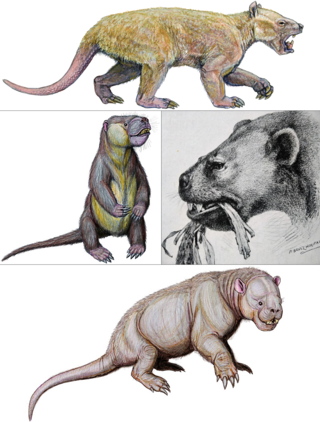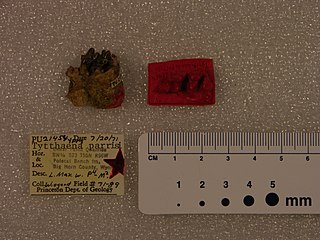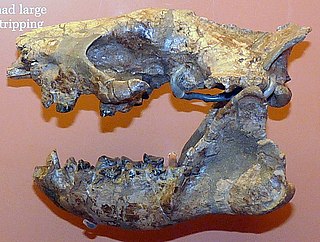
Sudamerica, literally "South America" in Spanish, is a genus of mammal from the extinct suborder Gondwanatheria that lived in Patagonia, Argentina and Antarctica from the Middle Paleocene (Peligran), just after the end of the "Age of Dinosaurs", to the Early Eocene (Casamayoran).

Robert Milton Schoch is an American associate professor of Natural Sciences at the College of General Studies, Boston University. Following initial work as a vertebrate paleontologist, Schoch co-authored and expanded the fringe Sphinx water erosion hypothesis since 1990, and is the author of several pseudohistorical and pseudoscientific books.

Taeniodonta is an extinct order of eutherian mammals, that lived in North America and Europe from the late Cretaceous (Maastrichtian) to middle Eocene.

Dinocerata or Uintatheria, also known as uintatheres, is an extinct order of large herbivorous hoofed mammals with horns and protuberant canine teeth, known from the Paleocene and Eocene of Asia and North America. With body masses ranging up to 4,500 kilograms (9,900 lb) they represent some of the earliest known large mammals.

Cimolestes is a genus of early eutherians with a full complement of teeth adapted for eating insects and other small animals. Paleontologists have disagreed on its relationship to other mammals, in part because quite different animals were assigned to the genus, making Cimolestes a grade taxon of animals with similar features rather than a genus of closely related ones. Fossils have been found in North America, South America, Europe and Africa. Cimolestes first appeared during the Late Cretaceous of North America. According to some paleontologists, Cimolestes died out at the start of the Paleocene, while others report the genus from the early Eocene.

Bryanictis is an extinct genus of placental mammals from extinct subfamily Didymictinae within extinct family Viverravidae, that lived in North America, from the early to late Paleocene.

Didymictis is an extinct genus of placental mammals from extinct subfamily Didymictinae within extinct family Viverravidae, that lived in North America and Europe from the late Paleocene to middle Eocene.

Raphictis is an extinct genus of placental mammals from extinct subfamily Didymictinae within extinct family Viverravidae, that lived in North America during late Paleocene.

Tillodontia is an extinct suborder of eutherian mammals known from the Early Paleocene to Late Eocene of China, the Late Paleocene to Middle Eocene of North America where they display their maximum species diversity, the Middle Eocene of Pakistan, and the Early Eocene of Europe. Leaving no descendants, they are most closely related to the pantodonts, another extinct group. The tillodonts were medium- to large-sized animals that probably feed on roots and tubers in temperate to subtropical habitats.

The Wasatch Formation (Tw) is an extensive highly fossiliferous geologic formation stretching across several basins in Idaho, Montana, Wyoming, Utah and western Colorado. It preserves fossils dating back to the Early Eocene period. The formation defines the Wasatchian or Lostcabinian, a period of time used within the NALMA classification, but the formation ranges in age from the Clarkforkian to Bridgerian.

The San Jose Formation is an Early Eocene geologic formation in the San Juan Basin of New Mexico and Colorado.

Prolimnocyon is an extinct paraphyletic genus of limnocyonid hyaenodonts that lived in Asia and North America during the late Paleocene to middle Eocene. Prolimnocyon chowi is the earliest known member of the hyaenodontid family Limnocyonidae.

Tytthaena is an extinct genus of placental mammals from extinct subfamily Tytthaeninae within extinct family Oxyaenidae, that lived in North America from the late Paleocene to early Eocene.

Palaeanodonta is an extinct clade of stem-pangolins. They were insectivorous (myrmecophagous), possibly fossorial, and lived from the middle Paleocene to early Oligocene in North America, Europe and Asia. While the taxonomic grouping of Palaeanodonta has been debated, it is widely thought that they are a sister group to pangolins.
Wyonycteris is a genus of small mammals that existed in the late Paleocene and early Eocene epochs. The type species is Wyonycteris chalix, which lived in Wyoming during the Clarkforkian North American Land Mammal Age of the Paleocene and was originally proposed to be an early form of insectivorous bat. Later re-examination of the material has put this alliance in doubt, and the genus has instead been proposed as belonging to the subfamily Placentidentinae, within the family Nyctitheriidae. Similar fossil material of the same time period found in Europe was later discovered and described as new species, Wyonycteris richardi.
Azygonyx was a small tillodont mammal, likely the size of a cat to raccoon, that lived in North America during the Paleocene and Eocene in the early part of the Cenozoic Era. The only fossils that have been recovered are from the Willwood and Fort Union Formations in the Bighorn Basin of Wyoming, United States, and date to the Clarkforkian to Wasatchian, about 56 to 50 million years ago. Fifty-six collections that have been recovered thus far include the remains of Azygonyx. Azygonyx survived the Paleocene Eocene Thermal Maximum along with other mammals like Phenacodus and Ectocion, both of which were ground-dwelling mammals. Azygonyx probably was a generalist terrestrial mammal that may have roamed around the ground, but was also capable of climbing trees.
The Silveirinha Formation is an Early Eocene geologic formation of the Mondego Basin in the Região Centro of central-western Portugal. The sandstones, siltstones and conglomerates were deposited in an alluvial environment.

Metacheiromyidae is an extinct paraphyletic family of myrmecophagous placental mammals within extinct order Palaeanodonta, that lived in North America and Europe from the late Paleocene to middle Eocene.

Conoryctidae is an extinct family of mammals from extinct order Taeniodonta, that lived in North America and Europe from the early Paleocene to early Eocene.

Conoryctinae is an extinct subfamily of taeniodonts from extinct family Conoryctidae, that lived in North America from the early Paleocene to early Eocene.



















